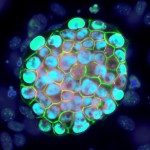Link to Pubmed [PMID] – 8080841
Int. Immunol. 1994 May;6(5):711-9
The establishment of the B cell repertoire depends on two major parameters. The first is determined by mechanistic processes that give rise to a great diversity of B cell receptors from a combination of multiple gene segments. The second is dominated by selective processes that recruit B cell clones via their immunoglobulin receptors. To assess the impact of these parameters on the composition of B cell repertoire, we constructed a mouse model displaying a B cell repertoire limited in its diversity. To this end, we disrupted the C kappa segment by gene targeting. B cells from such mutant mice do not express the kappa light chain. Their light chain repertoire is therefore limited by the expression of only four main lambda light chains: lambda 1, lambda 2(V2), lambda 2(Vx) and lambda 3. In this study we described the proportions of each lambda subtype in various lymphoid compartments. Our results show that the lambda 1 subtype is dominant in the spleen and the bone marrow. Moreover, lambda 1 prevalence is independent of the wild or mutant C kappa genotype. These results suggest that the mechanistic processes are mainly responsible for the bias in lambda subtype expression. On the other hand, the lambda 2(V2) and/or lambda 3 subtypes are expressed at higher levels in the peritoneal cavity. Their prevalence is again observed regardless of the C kappa genotype and seems to be due to B1 cells. These results suggest that different mechanistic processes could control lambda subtype expression in B1 and B2 cell lineages.

